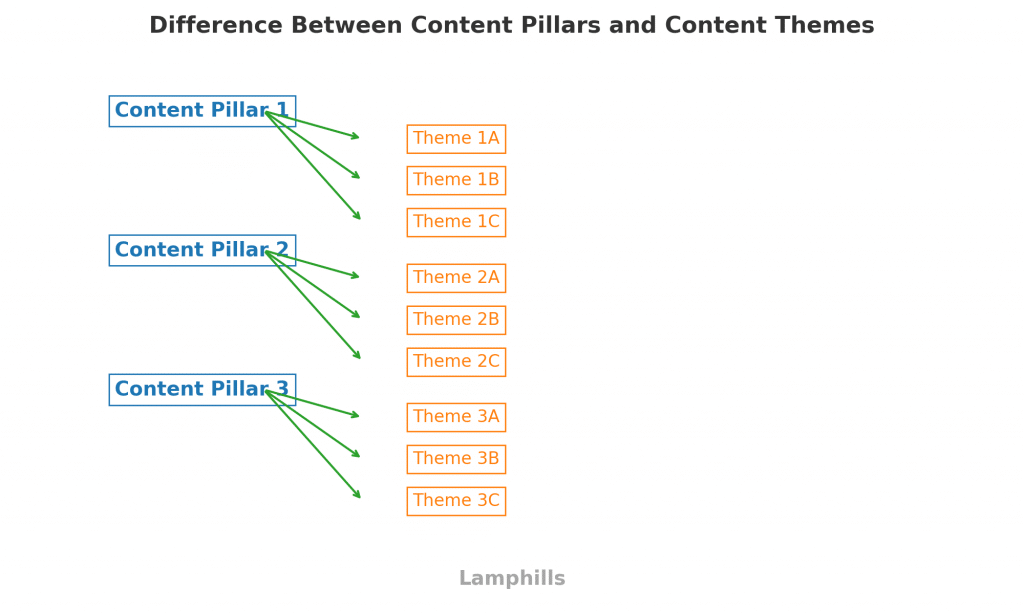Gone are those days when marketing strategy was solely reliant on a couple of basic tactics. We’re now in a modern era, where the key to successful marketing lies in the creation of effective content pillars. But where do you start? How do you ensure that your content is not just a flash in the pan, but a lasting pillar that supports your marketing efforts?
Don’t worry, I’m here to guide you through developing content pillars that will boost your marketing strategy to new heights. If you’re ready to go into strategic content creation, then buckle up because I’ve got some valuable insights to share with you.
Key Points
- Creating content pillars requires careful planning and strategic thinking to ensure they provide long-term value.
- Understanding the language and phrases your audience uses helps in crafting content that feels authentic and relatable.
- The use of pillar pages as comprehensive overviews helps establish your site as a credible source of information on broad topics.
- Incorporating both broad and specific content topics can help in building a well-rounded and authoritative presence in your niche.
- Consistently publishing content, as guided by a content calendar, can enhance audience engagement and predictability.
How I Create Effective Content Pillars for Marketing Strategy
As the famous saying goes, “Rome wasn’t built in a day,” creating effective content pillars for a marketing strategy requires careful planning and strategic thinking. Nowadays, where content is king, having a solid foundation of content pillars can help you gain your marketing efforts. As an expert, here are some tips for creating effective content pillars:
#1. Identify Your Audience
When identifying your audience for your content pillars, it’s like getting to know a group of friends. Imagine you are hosting a party and want to make sure your guests have the best time ever. You wouldn’t want to serve cheeseburgers to a group of vegans, right? So, understanding your audience is key to serving up the right content that will truly connect with them.
Let’s say you are a fitness influencer starting a blog. Your target audience might be busy working professionals in their 30s who are looking to incorporate more exercise into their daily routines. When you know this, you can create content pillars that address their pain points. This includes a lack of time to work out or their interests like quick and effective workout routines that fit into their busy schedules.
So, take your time to understand who your audience is, what they care about, and how you can best serve them well. It’s like being the perfect host at a party – knowing your guests well ensures a great time for everyone. For more, read this: HOW TO REACH YOUR IDEAL AUDIENCE: Mastering Social Media Targeting Strategies
#2. Define Your Goals
For content marketing, defining your goals is very important. You need to have a clear vision of what you want to achieve with your content efforts. Do you aim to increase brand awareness, drive more traffic to your website, or boost sales? Your content pillars should go with these marketing goals to maximize the impact of your efforts.
For example, if your goal is to enhance brand awareness, your content should focus on creating engaging and shareable material that draws with your target audience. If driving website traffic is your main objective, then your content should be optimized for search engines and shared on different platforms to reach a wider audience. I know it can be tasking but the result is lucrative. And if boosting sales is what you’re after, your content should educate and persuade potential customers about the value of your products or services. If you accomplish all these, then I bet you will get positive results.
#3. Conduct Keyword Research
Keywords are like the breadcrumbs that lead readers to your content. Personally, getting keyword analysis not only uncovers popular topics but also provides valuable insights into the language and phrases your audience is using to search for information.
When I conduct keyword research, I start with core topics related to the subject matter I want to cover. Then, I use tools like Google Keyword Planner, SEMrush, or Ahrefs to identify search volumes, competition levels, and related keywords. This process helps me get high-potential keywords that align with both user intent and search trends.
By understanding the keywords that are relevant to my audience, I can direct my content to address their specific needs and interests. In essence, this approach enhances the visibility of my content in search engine results and establishes credibility and authority in the respective niche. For more insights, read this article: Top 10 Keyword Research Services in 2024
#4. Brainstorm Content Ideas
If there’s something you must know, then I think brainstorming content ideas, especially for effective content pillars, is crucial. To create valuable content that’ll draw your audience and reinforce your brand’s message, brainstorming is key.
To start brainstorming content ideas for your pillars, consider what topics would be most valuable and relevant to your target audience. Think about their interests, pain points, and what information they are seeking. This can help you create content that not only engages but also provides value to your readers.
For example, I usually turn to social media platforms like Instagram and Twitter. These platforms give me trending topics, popular content formats, and what users want. Also, I use tools like Google Trends and BuzzSumo to track relevant topics and see what’s currently popular in my industry.
Remember, the key to successful content pillars is to offer a mix of unique and trending topics that appeal to your audience while staying true to your brand’s messaging.
#5. Create Pillar Pages
Pillar pages are like the main hubs of information on your website. They cover broad topics that are relevant to your industry, acting as the foundation for more specific subtopics that are explored in cluster content.
Just see pillar pages as the starting point for readers who want to go into a particular subject. By linking pillar pages to cluster content, you provide a clear path for users to navigate your site and increase your website’s authority in the eyes of search engines. From there, it’ll improve your SEO performance.
Therefore, creating pillar pages is a smart strategy to organize and display your expertise while making it easier for both visitors and search engines to find and understand your content. Amazing isn’t it?
#6. Develop Cluster Content
As the saying goes, “It’s not just about the destination, but the journey too.” When it comes to creating cluster content for your website, pillar pages are the main destinations and the cluster content are the exciting stops along the way.
Imagine you are on a road trip, and each cluster content piece is like a unique roadside attraction that adds value and depth to your journey. If you link these cluster content pieces back to your pillar pages, you are essentially creating a roadmap for your audience and search engines to navigate through your content seamlessly.
So, just like how each pit stop enhances your road trip experience, each cluster content piece enriches your website’s structure. Additionally, it boosts your organic search rankings. Hence, don’t underestimate the power of these smaller pieces that collectively contribute to the success of your content strategy.
#7. Plan Your Content Calendar
Here is the stage most people fail to do when it comes to content marketing – planning their content calendar. I can’t stress enough how important it is to have a well-thought-out content calendar in place.
A few years back, I was assisting a friend who had just started a blog. She was excited about creating content and had some great ideas in mind. However, she struggled to publish consistently. She would often write posts on the fly and hit the publish button whenever she felt like it. As a result, her audience was left confused about when to expect new content, and her blog’s traffic suffered.
After discussing her challenges, we sat down and worked on developing a content calendar. We mapped out the topics she wanted to cover, set realistic deadlines for each post, and decided on the best times to publish based on her audience’s behavior. Guess what? Within a few weeks of sticking to the content calendar, we noticed a significant improvement in her blog’s performance.
So, if you’re struggling with content consistency, start now and plan your content calendar. Trust me, it can make a world of difference in your content marketing efforts.
#8. Analyze and Optimize
Last but not least is analyzing and optimizing. Of course, analyzing and optimizing your content pillars is crucial for ensuring they are performing at their best. It’ll give your content strategy a tune-up to keep things running smoothly.
First things first, go into your analytics tools to track important metrics like website traffic, engagement levels, and conversion rates. These numbers will give you valuable insights into things that’ll draw your audience and where there might be room for improvement.
Once you have this data in hand, start optimizing. I mean focusing your content pillars to better align with what your audience wants, updating outdated information, or experimenting with different formats or approaches to see what works best.
Remember, optimization is an ongoing process, so I advise you not to be afraid to test and refine your content pillars regularly.
Content Pillars Template
A content pillars template is like a roadmap for your content strategy. Just imagine pillars holding up a structure – each pillar represents a key theme or topic that your content will focus on. These pillars are the foundation of your content strategy, guiding everything you create.
So, what are you waiting for? Start crafting content that not only engages but also drives results. Download the template now and let’s get your content pillars marketing strategy in tip-top shape!
Content Pillars Template
What Are Content Pillars For?
Content pillars are like the foundational themes or topics that you consistently create and share content around. Imagine them as the main categories that represent your brand or business. In essence, they help you stay focused, consistent, and organized in your content creation efforts.
How To Create Pillar Content?
Creating pillar content involves identifying key topics essential to your target audience and developing comprehensive, in-depth articles or guides around them. First, research popular topics in your niche and select ones relevant and evergreen.
Next, organize your content in a logical structure with sub topics and headings for easy navigation. Make sure to provide valuable insights, examples, and practical tips to engage your readers and establish yourself as an authority in your field.
Don’t forget to promote your pillar content through various channels to reach a wider audience and drive traffic to your website. You can get more insights from these articles:
10 Proven Strategies To Increase Website Traffic In 2024
10 Brand Marketing Tactics That Actually Drive Results
Are Content Pillars Still Relevant?
Yes, content pillars are still relevant in today’s digital world. I have personally found them incredibly useful in organizing and structuring content for various projects.
By establishing content pillars for my marketing strategy, I have been able to maintain consistency in messaging and keep my content focused on key themes. Also, ensure that my audience receives valuable and relevant information. So, now you can see that content pillars will help you stay on track with your goals.
What Is The Difference Between Content Pillars And Content Themes?
Of course! Content pillars and content themes are both important concepts for creating a strong content strategy, but they serve slightly different purposes.
Content pillars as the main topics or categories that represent the core areas of your business or brand. These are the foundation of your content strategy and should align with your goals and values. Additionally, they help to establish your brand’s identity and provide a framework for organizing your content.
On the other hand, content themes are more specific and focused than content pillars. They are the subtopics or specific angles that you explore within each content pillar. Content themes allow you to create variety in your content while staying true to your brand’s messaging and goals.

What Is The Difference Between Content Pillar And Topic Cluster?
Just see the content pillar as the main hub of information on a particular topic. It’s like the big umbrella under which all related content falls. On the other hand, topic clusters are like little branches stemming from the content pillar. They are more specific subtopics that delve deeper into the main topic and link back to the pillar for a comprehensive overview.
In simple terms, content pillars give you the main idea, while topic clusters break it down into more specific details.
Now that you know the secret to creating effective content pillars for a marketing strategy, it’s time to put them into action. Yeah! Create a plan, align it with your business goals, and watch your marketing efforts soar. Don’t forget to use social media platforms for your content pillars.
Related Articles
Top 5 Brand Pillars: Why Your Business Can’t Afford to Ignore Them!
How To Create Great Content Pillars (With Examples)
Building Effective Content Pillars: A Guide for Nigerian Brands






